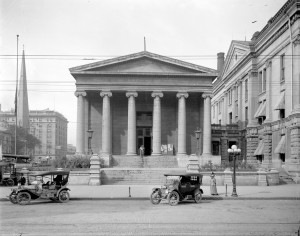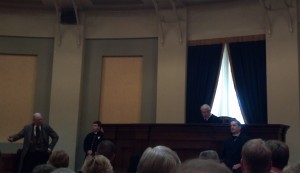Dayton, Ohio is no stranger to murder – just watch the news, and it seems there’s one almost every day. But a hundred years ago, murder was a novelty, and a trial for such, a spectacle people came to see from miles away. Yesterday afternoon, Dayton History reenacted such a case in the original Old Courthouse, that still stands at Third and Main today, giving us a chance to see what it might have been like, and even participate in the trial, over a hundred years later.

Dayton's Old Courthouse in the early 20th century
Upon entering the courthouse, Dayton History staffers gave the audience a sheet of the text of actual newspaper articles printed at the time. They were printed on yellow photocopy paper, which was amusing considering some of the yellow journalism within. 🙂
In September of 1896, 20-year-old Albert Frantz was accused of murdering Bessie Little, the 23-year-old woman he’d been seeing, whose body was found in the Stillwater River. There were a lot of suspicious circumstances leading up to the verdict of whether Miss Little had committed suicide, as was initially thought, or if she died by another’s hand. Witnesses described how Bessie was caught “in a compromising position” with Mr. Frantz in her parents’ barn, which led to him putting her up in a hotel soon after (there were few living options for single women in those days). It also came to light that she’d seen a doctor, and had been declared pregnant, and Mr. Frantz supposedly wanted to marry her, but was unable due to being underage – and his parents refused to give consent.
At the hotel, they found a letter from Bessie, addressed to Mr. Frantz’s parents, begging them to let their son marry her. But the most telling evidence was found on a newly-constructed bridge, that crossed the Stillwater into what was then a lightly-populated part of town: blood on the bridge itself, and a track mark from it that looked like a buggy had been driven through it.

Last weekend's reenactment
Mr. Frantz had been planning to take his sweetheart for a ride the last evening she was seen alive.
Other evidence was produced throughout the trial, which in reality, reconvened throughout the next three months. One item was the woman’s skull! It had been kept in a jar of alcohol at the police office, after her body had been exhumed from her resting place in the potter’s field in Woodland Cemetery, when her manner of death was first called into question. When the skull was brought in, the “bailiff” opened the courtroom’s windows, due to the undoubtedly-horrendous smell! The reason the skull was unearthed was probably the biggest factor in the ultimate determination of the court: Miss Little had been shot in the head through the ear, twice.
The prosecution and defense both presented their closing statements – both waxing rather melodramatic at times – then the jury (which were picked from the audience) went to deliberate. As in a modern, Ohio court proceeding, the jury was instructed to issue a guilty verdict only if the prosecution was able to “remove all reasonable doubt.” I was guessing they’d say “Not Guilty,” because despite the evidence, the state hadn’t removed all doubt. When they issued their verdict, the jury agreed, and the “judge” told the defendant he was free to leave.
The Dayton History staffers handed us another sheet of newspaper articles on the way out, containing the results of the trial: Guilty of First Degree Murder! It turns out that, after a series of failed appeals, Mr. Frantz became the fourth person in Ohio to die by electric chair, almost a year later.
Can you imagine that quick of an appeals process now? Or presenting the actual corpse as evidence in a trial? (Thank goodness for modern photography and videography!) And interestingly enough, do you think the modern-day jury was more compassionate, more discerning of the evidence, or maybe just more hard of hearing? (There was a lot of echo in the courtroom, and yes, it was hard to hear sometimes.) Anything fun like this reenactment in your home town? Please share!
Note: This program will be presented three times next weekend, August 5, 6, and 7 – Details at DaytonHistory.org.
Want to learn more about this case? Check out Spilt Blood, by Curt Dalton (one of the researchers for the reenactment)
More at the My Town Monday blog
Historic photo via Dayton History


